- Submissions

Full Text
Novel Research in Sciences
Research on High-Strength Solidification Technology of Tight Oil and Gas Drilling Waste
Yang Boyuan1, Chen Erding1*, Fan Yu2, Wang Xiaoqiang3, Li Gongrang4 and Huang Weian1
1School of Petroleum Engineering, China University of Petroleum, China
2Southwest Oil and Gas Field Branch of Chinese Petroleum, China
3Sinopec Petroleum Engineering Technology Research Institute Dezhou Continental Shelf Petroleum Engineering Technology Co, Ltd, China
4Drilling Technology Research Institute of Sinopec Shengli Petroleum Engineering Co, Ltd, Dongying, China
*Corresponding author:Chen Erding, School of Petroleum Engineering, China University of Petroleum, China
Submission: January 15, 2021;Published: March 11, 2021
.jpg)
Volume6 Issue3March, 2021
Abstract
The development of high-strength solidification process optimization research is of great significance for the resource utilization of oily and salty drilling waste, in response to the tight oil and gas drilling waste treatment needs. The orthogonal test method is used to optimize the high-strength curing formula with compressive strength as the evaluation index. Analyzing the hydration products and microstructure of the solidified material by XRD and SEM and analyzing the formation mechanism of the strength of solidified drilling waste. According to the orthogonal test, the best curing system formula is “100g waste+0.4g modifier+5gH2O+19gMgCl2+ 21g fly ash+28gMgO”. The best compressive strength is 39.65MPa at 28d and the treatment rate is 69.78%. The increase of NaCl, quartz, molding pressure and barite content can help increase the strength of the cured product, and the increase of the content of clay minerals and soaking will cause the destruction of the strength of the cured product. The high strength of the curing system is due to the formation of a hydration product 5Mg (OH)2·MgCl2·8H2O mechanical interlocking structure in the composite curing system. The research results show that the high-strength solidification technology of tight oil and gas drilling waste can effectively promote the future development of drilling waste environmental protection technology.
Keywords:Drilling waste; Tight oil and gas reservoir; Orthogonal test; High strength curing; Environmental protection
Introduction
Nowadays, tight oil and gas reservoirs have gradually become a new field of oil and gas resource development [1-3]. However, they are difficult to exploit and complex to handle. Drilling waste is highly polluting [4,5]. Therefore, it is necessary to solidify drilling waste with high intensity. In-depth research on process technology. [6] used fly ash to solidify the waste mud to generate C-S-H gel and calcium aluminate hydrate, which improved the gelling component and hardening quality of the waste mud system. [7] made a systematic review of the research and application status of waste drilling fluid solidification treatment technology in our country. [8] solidified the waste mud in Shengli Oilfield according to the orthogonal test method to determine the best ratio of curing agents, and the problem of high COD value of the leachate was solved. [9] treated the four materials of waste drilling fluid in central Sichuan with gypsum, blast furnace slag, fly ash, and Portland cement in a ratio of 2:5:8:10 to compound curing agents, and the effect was good. To this end, this paper aims at the optimization of the formulation of the high-strength solidification system of tight oil and gas drilling waste, and the research about influencing factors of the strength of the high-strength solidification system of tight oil and gas drilling waste. The realization of high-strength solidification technology will promote the development of drilling waste environmental protection technology.
Orthogonal Optimizations of Curing System
Six components of MgO, MgCl2, water, modifier, activator and fly ash are selected as experimental parameters. According to the L25(56) orthogonal table design optimization experiment scheme and high-strength curing experiment method, the compressive strength of the specimens of different ages was measured, and the best curing system formula suitable for the treatment of solid waste in tight oil and gas drilling was found [10-12]. Taking 28d compressive strength as the optimization index, the compressive strength of cured specimens of each system is shown in Figure 1. The final optimized composite curing system formula is 100g waste + 0.4g modifier + 5gH2O + 15gMgCl2 + 25g fly ash + 30g MgO, and the compressive strength of the cured specimen increases with the increase of curing age, and the highest compressive strength the strength reaches 36.39MPa. According to orthogonal experiments and other experimental principles, it is determined that the best curing system formula is 100g waste + 0.4g modifier + 5gH2O+19gMgCl2+ 21g fly ash + 28gMgO. The best compressive strength is 39.65MPa at 28d, which meets the standard Compressive strength requirements, the total amount of processed industrial waste accounts for 69.78%, which has a good waste treatment capacity [13-15].
Figure 1:The curve of compressive strength of cured specimens of each system under 28d age.

Analysis of Factors Affecting Curing Strength
Influence of molding pressure
In the experiment, the optimized curing system formula (100g waste+0.4g modifier+5gH2O+19gMgCl2+21g fly ash+28gMgO) was selected, and the molding pressure was 1MPa, 3MPa, 5MPa, 7MPa, 9MPa for 3min. Under the condition of no external interference and 14 curing days, the compressive strength is the best when the molding pressure is 9MPa. The compressive strength of the cured specimen under different molding pressures is shown in Figure 2. The increase of the molding pressure causes the plastic deformation of the solid particles, increasing the contact area of the solid particle hydration reaction, reducing the porosity, the structure is more compact, and the compressive strength of the cured specimen is greatly improved.
Figure 2:The curves of compressive strength of cured specimens aged 14 days under different molding pressures.

Effects of soaking
In the experiment, the optimized curing system formula (100g waste+0.4g modifier+5gH2O+19gMgCl2+21g fly ash+28gMgO) was selected. After curing for 7 days, the specimens were immersed in a simulated neutral water environment (pH=7). And weak acid environment (pH=4), weak alkali environment (pH=10), it is found that the compressive strength effect of the unsoaked system formula is the best, and the change trend of its compressive strength is shown in Figure 3. Soaking has a negative effect on the compressive strength of the curing system, which will decompose the hydration products in the system and destroy the strength structure, but the specimens after soaking still have partial strength.
Figure 3:Diagram of relationship between immersion time and strength of cured specimen.
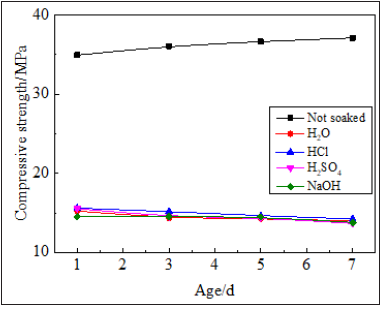
Influence of waste composition
The optimized curing system formula (100g waste+0.4g modifier+5gH2O+19gMgCl2+21g fly ash+28gMgO) was selected in the experiment, and simulation analysis of waste content during drilling under different reservoir lithology and drilling fluid systems. Analyzing the relationship between the composition and the strength of the curing system.
A. The content of waste: The waste content was increased to 120g, 140g, 160g, and 180g for 14 days of curing, and the compressive strength changes were observed. The optimal waste content of the system was 100g, and the curing system had a certain waste treatment capacity. The specimen was cured. Figure 4 shows the compressive strength under different amounts of waste.
Figure 4:The relationship between the compressive strength of cured specimens and the amount of waste added.

B. The content of quartz: Simulating solid waste from sandstone oil and gas reservoirs, adding 5, 10, 15, 20% of quartz sand to the wastes for 14 days of curing, observing the changes in compressive strength, and finding the optimal waste quartz sand addition for the system It is 20%, and the compressive strength of the cured specimen under different quartz sand additions is shown in Figure 5. Quartz has a supporting role in the curing system, filling the internal pore structure, which is conducive to curing.
Figure 5:The relationship between the compressive strength of the cured specimen and the quartz content.

C. The content of NaCl: Simulating the solid waste after drilling in the salt-gypsum layer or brine drilling fluid system, adding 2, 5, 8, 10% NaCl to the waste for 14 days of curing, observe the changes in compressive strength, and find the best of the system The NaCl addition amount of the waste is 10%, and the compressive strength of the cured specimens under different NaCl addition amounts is shown in Figure 6. With the increase of NaCl content, the compressive strength of the curing system gradually increases. The curing system has a strong resistance to salt and bittern. The strength of the system is little affected, and the strength of the system is slightly improved.
Figure 6:The relationship between the compressive strength of the cured specimen and the content of NaCl.
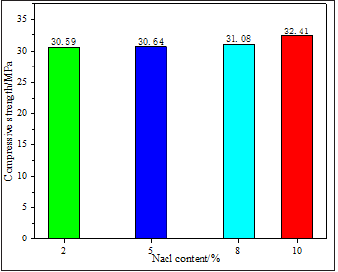
D. The content of oil: Simulating the solid waste after drilling into the reservoir, adding 0, 2, 4, 6, 8% of white oil to the waste for 14 days of curing, and it is found that the optimal waste white oil addition amount of the system is 0%, the compressive strength of the cured specimen under different oil content is shown in Figure 7. As the oil content increases, the strength of the curing system is significantly reduced. The oil component adheres to the surface of the material during the curing process, which hinders the progress of the hydration reaction and fails to form a strength structure, resulting in a decrease in the strength of the cured specimen.
Figure 7:The relationship between the compressive strength of the cured specimen and the change of the oil content.
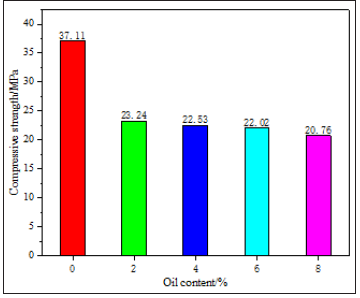
E. The content of barite: Simulating the solid waste after drilling in a heavy drilling fluid system, adding 5, 10, 15, 20% of barite to the waste for 14 days of curing, and find the optimal waste barite dosage for the system It is 20%, and the compressive strength of the cured specimen under different barite content is shown in Figure 8. As the addition of barite increases, it is beneficial to increase the strength of the curing system.
Figure 8:The relationship between the compressive strength of the cured specimen and the content of barite.

F. The content of clay: Simulating the solid waste after drilling in the mudstone section, adding 0, 5, 10, 15, 20% of the clay to the waste for 14 days of curing, and it is found that the optimal waste clay addition for this system is 0%, The compressive strength of the cured specimen under different clay content is shown in Figure 9. As the amount of clay increases, the strength of the curing system gradually decreases. Clay minerals have extremely low strength, which can neither carry out hydration reaction nor play a supporting role, which greatly affects the strength of the curing system.
Figure 9:The relationship between the strength of the cured specimen and the change of the clay content.
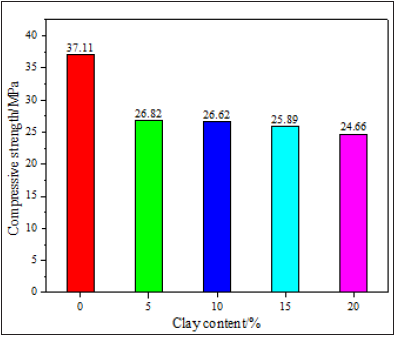
Structural Composition and Pollution Characteristics Analysis
Microscopic analysis of solidified waste structure
The experiment chooses the plan with the highest compressive strength after 28 days of curing in the orthogonal optimization experiment a. 100g waste + 0.4g modifier + 3gH2O + 20g MgCl2 + 25g fly ash + 35gMgO, the medium strength plan b. 100g waste +0.6g modifier+0gH2O+20gMgCl2+10g fly ash+30gMgO and the lowest strength plan c. 100g waste+1.0g modifier+0gH2O+30gMgCl2+20g fly ash+15gMgO solidified specimen, using SEM to analyze the three microstructures to 3000 times and 7000 times respectively, as shown in Figures 10 & 11.
Figure 10:SEM analysis of the microstructure of plan a, b, c cured specimens at 3000 times magnification

Figure 11:SEM analysis of the microstructure of plan a, b, c cured specimens at 7000 times magnification.

The high strength of the curing system is due to the formation of the hydration product 5Mg(OH)2·MgCl2·8H2O in the composite curing system. The strength of the cured product is closely related to the shape, diameter and arrangement of the hydration product. The dense hydrated products are interlaced inside the crystal clusters to form a network mechanical interlocking structure, which greatly improves the strength of solidified waste.
Analysis of hydration products
Figure 12:X-ray diffraction analysis results of cured products with different strengths (28d curing).
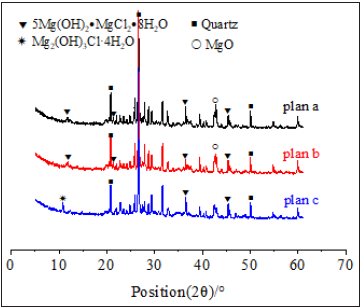
XRD and SEM were used to analyze the composition and structure of hydration products in high-strength plan a, medium-strength plan b, and low-strength plan c. Three strength specimens in plan a, plan b, and plan c were selected for analysis, and the analysis results are shown in Figure 12. The compressive strength of solidified drilling waste is related to the content of hydration product 5Mg(OH)2·MgCl2·8H2O, and the strength of the system increases with the increase of hydration product content. Selecting the strength test specimens which are the same as the plan a, plan b and plan c.
Plan d (100g waste+1.0g modifier+13gH2O+15gMgCl2+10g fly ash+35gMgO) and
plan e (100g waste+0.8g) Modifier+5gH2O+20gMgCl2+20g fly ash+25gMgO) and
plan f (100g waste+1.2g modifier+13gH2O+20gMgCl2+15g fly ash+15gMgO)
were analyzed, and the analysis results are shown in Figure 13. Comparing and analyzing the XRD analysis results of the test pieces, the test pieces with similar hydration products have similar strength levels, and they have similar characteristic peaks, indicating that the high-strength curing experiment has certain repeatability and reliability.
Figure 13:XRD analysis comparison chart of cured material of the same strength (28d curing).

Analysis of pollution characteristics of solidified drilling waste extract
Select the best curing system formula test piece, curing system plan a, plan b, plan c and drilling waste for leaching experiments. The heavy metal ion content and COD value in each leaching solution are tested according to the pollutant environmental protection performance evaluation method, and finally the high strength the sealing effect of the curing system was analyzed, and the experimental results are shown in Table 1. The concentration of heavy metal ions in drilling waste is greatly reduced after being treated with a high-strength solidification system. The chemical oxygen demand of the leachate meets the requirements of national emission standards and has good compatibility with the environment [16].
Table 1: Analysis results of waste pollution characteristics.

Note: “—”Means not detected, the concentration is too low and not within the detection range of the instrument.
Conclusion
1. Taking compressive strength as the evaluation index, through orthogonal test analysis, it is determined that the best curing system formula is 100g waste+0.4g modifier+5gH2O+19gMgCl2+ 21g fly ash+28gMgO. The best compressive strength is the 28th 39.65MPa, the treatment rate is 69.78%.
2. Through the analysis of the factors affecting the strength of the high-strength solidification system of drilling waste, the increase in molding pressure effectively increases the overall compressive strength of the solidified specimen. Soaking has a negative effect on the compressive strength of the solidified system. The strength of the solidified material increases with quartz, NaCl, and weight. The spar content increases with the increase and decreases with the increase of the oil and clay mineral content.
3. The hydration product 5Mg(OH)2·MgCl2·8H2O in the composite curing system forms a mechanical interlocking structure inside the crystal clusters, which is the root cause of the high strength of the curing system.
References
- Law BE, Pollastro RM, Keighin CW (1986) Geologic characterization of low-permeability gas reservoirs in selected wells, greater green river basin, Wyoming, Colorado, and Utah. AAPG Special Volumes 66: 253-269.
- Yang ZX, Wang R (2014) Research on development status and strategy of tight oil and gas fields in ordos basin. Journal of China University of Petroleum: Social Science Edition 2014(2): 8-14.
- Kang YZ (2012) Characteristics of unconventional tight rock reservoirs in China. Natural gas industry 32(5): 1-4.
- Kang Y (2016) Resource potential of tight sand oil & gas and exploration orientation in China. Natural Gas Industry.
- Wu MX (2012) Research on environmental impact of waste water-based drilling fluid and solidification treatment technology. Northeast Petroleum University, China.
- Dong SM, Wang PQ, Chen ZY (2008) Oil and gas field drilling waste mud treatment technology. Natural gas industry 28(2): 87-89.
- He L, Zhou FS, Liu Y (2007) Drilling and completion waste solidification treatment technology and its industrial application. Drilling fluid and completion fluid 24(S): 55-58.
- Zheng LW, Zhang W, Wang LL (2017) Research on composite curing agent of abandoned drilling mud in shengli oilfield. Shandong Science 30(2): 106-109.
- Pan BF, Li SG, Yang B (2009) Research on solidifying agent of waste drilling mud and its solidification mechanism in central sichuan. Jianghan Petroleum Technology 3: 70-72.
- Kimura H, Sasamori K, Inoue A (2007) High strength Al-Ti-Fe alloys consisting of amorphous and fcc-Al phases prepared by rapid solidification. Materials Transactions 37(11): 1722-1725.
- Zhang XB, Qiu ZS, Tao RD (2011) Novel technology of high strength stabilization/solidification of drilling waste. Journal of China University of Petroleum 35(2): 172-177.
- Shan C, Jing Z, Pan L(2011) Hydrothermal solidification of municipal solid waste incineration fly ash. Waste Manag 37(2-5): 1521-1527.
- Li YM, Li W, Wang ZH (2019) Mix design and mechanical properties of construction waste recycled cement stabilized base. Road construction machinery and construction mechanization 36(7): 52-57.
- Zhang LL, Wu CL, Wang AJ (2015) Study on the performance of foamed concrete compact blocks from construction waste recycled materials. New building materials 42(11): 65-68.
- Li LY (2015) Application of industrial solid waste in the treatment of soft soil foundation in shanghai. Fly ash 27(6): 12-15+19.
- Wang XQ (2018) Research on high strength solidification and surface coating technology of tight oil and gas drilling waste. China University of Petroleum, China.
© 2021 Chen Erding. This is an open access article distributed under the terms of the Creative Commons Attribution License , which permits unrestricted use, distribution, and build upon your work non-commercially.
 a Creative Commons Attribution 4.0 International License. Based on a work at www.crimsonpublishers.com.
Best viewed in
a Creative Commons Attribution 4.0 International License. Based on a work at www.crimsonpublishers.com.
Best viewed in 







.jpg)






























 Editorial Board Registrations
Editorial Board Registrations Submit your Article
Submit your Article Refer a Friend
Refer a Friend Advertise With Us
Advertise With Us
.jpg)






.jpg)













.bmp)
.jpg)
.png)
.jpg)














.png)

.png)



.png)






